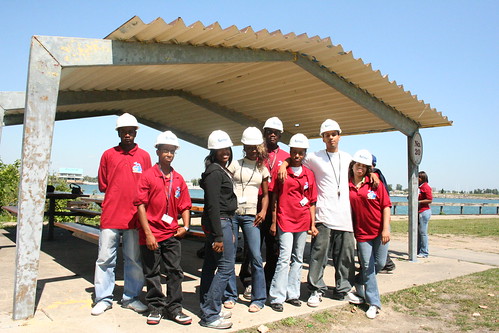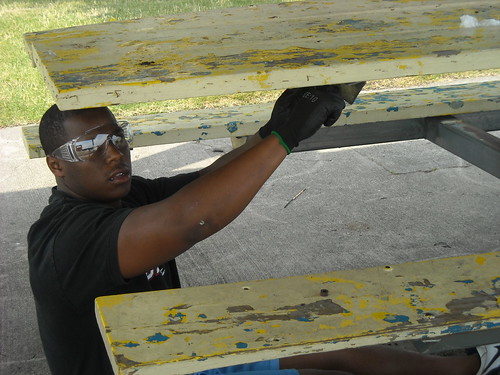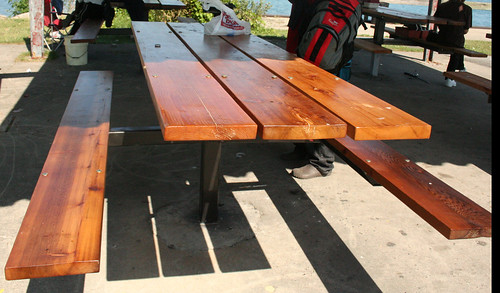
Tuesday, September 1, 2009
Poems on Environmental Justice
Urban Renewal: an Ode to DWEJ
by Brandon Gatson
Let’s clean up the ‘hood
Rebuilding the homes
Restructuring the infrastructure
Refurbishing the furniture
So the spirit blossoms
Let’s plant seeds
Not to just grow trees
But rather produce forests in the people
So the fruits they bear
Feed the multitudes
Detroit needs environmental justice
We need geothermal energy
Heating up the water
Reheating the hearts in the home
So we can warm up the quality of life
Let’s remove the contamination
Remediating the hazardous waste wasting our lives
Abating the toxi-city
For we’re dying from lead poisoning
We are Detroiters Working for Environmental Justice
Check out poems about environmental justice by other authors here:
Poems by Bunyan Bryant, Ph.D. of University of Michigan
Environmental Justice Initiative poetry slam (video) - UM School of Natural Resources
Wednesday, August 26, 2009
The Beginning of a Beautiful Friendship
Friday, Aug 21 was another great day for Detroiters Working for Environmental Justice. Our youth program (YOPAP) and community education program (CHATS) collaborated with the Detroit branch of the Sierra Club, the office of State Rep Rashida Tlaib, community activists from Southwest Detroit, The Friends of the Detroit River and Canadian environmental organizations Polaris Institute and Sierra Youth Coalition for an international exchange. The Canadian groups visited Detroit to learn about our environmental justice issues, as well as to share their own. This exchange helped youth realize that both countries have to deal with the consequences of heavy industry along the Detroit River.
The activities included a bus tour of Detroit’s southwest side, where various community leaders explained that their heavily industrialized community suffers from an extremely high rate of cancer-related deaths. This is a direct result of corporate industrial irresponsibility and neglect. For example, sediment emitted from the Marathon oil refinery and DTE’s coal-burning plant coats the community and settles into the soil, killing trees. US Steel and Severstall’s smokestacks release air pollutants. Because there are so many different industries and air pollution is hard to track, it’s hard to say what is coming from where. But roofs, which are supposed to average 20-30 years, only last about 10 years in this community, and there is often a filmy residue left on the cars. On a single block, 13 people have died of cancer-related deaths.
There is no shelter where the residents of 48217 can escape the constant bombardment of air, water, soil and noise pollution. For decades, this community has also had to live with shaking and vibrating homes, a result of salt mine drilling, which takes place hundreds of feet beneath its polluted soil.
This almost-forgotten part of Detroit doesn’t even have a Homeland Security evacuation plan – in the case of an oil spill at Marathon, for example - like other surrounding communities, such as Dearborn and Melvindale. The petroleum, auto, salt, gypsum and commercial energy industries are deeply entrenched in this mostly Latino and African American community. Marathon Oil’s expansion will take another entire city block to refine tar sands imported from Canada, increasing land, water and air pollution in both countries, while only creating six new jobs, none of which will go to the surrounding community.
After the bus tour, the group was honored to meet with Detroit City Councilwoman JoAnn Watson. Councilwoman Watson happens to be the only city council member with her own environmental justice task force. Each member of the group was personally welcomed, thanked by the councilwoman and presented with a Spirit of Detroit Award. This award recognizes “exceptional achievement, outstanding leadership, and dedication to improving the quality of life.”
The day was topped off with a meet, greet, all-you-can-eat-pizza and salad buffet at Pizzeria Venti located on Wayne State campus. The Canadian group brought a movie called Toxic Trespass, which described the health impacts of environmental pollutants on children. A particularly interesting fact learned from the video is that air and water pollution from Zug Island is affecting health in Canada.
--- generated interest in learning more about environmental issues beyond their own communities. Suggestions included the Polaris Institute and the Sierra Youth Coalition hosting similar events for Detroit groups in Canada, and DWEJ visiting a Nigerian environmental organization attempting to shed more light on environmental issues in Africa.
The successful exchange of ideals and information has laid the foundation for future international collaboration.
Monday, August 24, 2009
Summer 2009
All of the groups had weekly computer trainings and counseling sessions. Here is one group in session with Ms. Myers.
One group focused on testing the water quality at the Belle Isle beach. Public beaches are supposed to be monitored for e. coli. When e. coli levels are above 200 colonies per 100 mL (2 colonies on a 1 mL sample test, according to EPA standards), public beaches are supposed to be closed because of the health risk. However, Belle Isle beach is not monitored. The youth tested the beach about twice a week for six weeks, and the e. coli level reached as high as 13 colonies on one 1mL sample - and the beach stayed open.
1 mL of the sample water from the beach is pipetted onto a 3M water test called petrifilm. Then this sample is incubated for 48 hours to allow bacteria to grow.



This sample is a bit messy, but those blue dots with gas bubbles are E. coli colonies! E. coli is a bacteria that is used as an indicator for fecal contamination in the environment. The red dots are coliform, which are generally harmless. On August 4, 2009, the water sample showed 13 E. coli colonies.
Another group worked on restoring a picnic shelter at the fishing dock on Belle Isle with help from Phillip Cooley. The youth learned to sand, clearcoat and weld the new benches. They also scraped off the old paint and are now in the process of repainting the structure.


Thanks to all those who donated the hard hats to DWEJ youth!
Damian Chatman, a summer intern, works on an old table.

Here you can see one of the newly restored tables.

Check back soon for more updates about the other two groups!